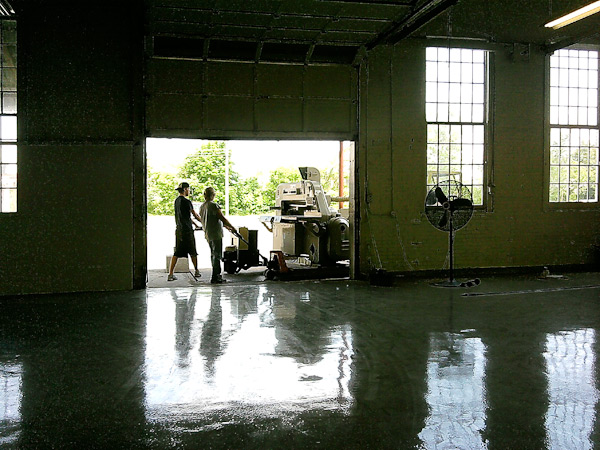For those curious enough to venture into the beautiful and gentle rolling hills of the Scottish countryside, a thirty minute serene drive southwest from Edinburgh will find you in the company of friendly smiles, a easy-going pace of lifestyle, and the private farm workshop that is The Hunter Press. Lyndsey Hunter is the energetic entrepreneur manning the presses there and she let us in for a tour of her printing paradise — a true gem found in the heart of Scotland. She sat down with us between ink runs to talk shop, about her passions as a printer, and bringing more letterpress to the Scottish community.


THE LOCATION The print studio is located on an arable farm just 12 miles outside of Edinburgh. It’s a nice peaceful spot, not too far from the nearest town but quiet enough to feel as though we’re in the countryside. The print space is adjoined to my husband’s blacksmiths workshop so things can get a little noisy at times. We’re currently restoring a 300 year old property further north in Highland Perthshire which we plan to relocate to within the next year. The print studio will then be located in one of the adjoining cottages.
I like to have a central hub which I can access from every point within the studio. Ours is a large prep/finishing table which often doubles as a set up area, computer station and photography surface.
SHOP SIZE 500 square feet.
FAVORITE THING ABOUT THE SHOP It’s quiet on the farm, away from traffic and city hustle and bustle, which really fuels my creativity. Within the studio, my favourite thing would have to be the old type cabinets which are used to hold surplus paper stock and our cutting dies. The drawers have taken a bit of a beating over the years, but add so much warmth to the space.
FLOORING MATERIAL Sturdy painted concrete below the printing presses. We added some comfy hard wearing carpet across the rest of the space. The studio can get really cold so it’s nice to have a little bit of comfort during those cold months.
TYPE OF SHOP Commercial but closed to visitors.
THE PRESSES 3 Heidelberg Windmills 10×15, one of which has been converted for Foil Printing, 1 Harrild and Sons Proofing Press in need of full restoration, and we are hoping to replace one of the Windmills with a Korrex Berlin Proofing Press very soon.
MOST VALUABLE SHOP TOOL Not a tool exactly but I definitely couldn’t run things without my wood burner on those chillier days! I’m not too sure how I managed without it at the beginning now.
FAVORITE INK + COLOR Ink of choice would be VanSon Rubber Based Inks. I often use oil based for specials. Current favourite colour to mix would be mint green.
CLEAN-UP ROUTINE Clean up is my least favorite part of the day! Luckily the Windmills are fairly straightforward to clean. I use a water-miscible roller and blanket solution with cotton rags and blue roll.
OIL OF CHOICE Castrol Magna 150 Mineral Circulating Oil.
CLEAN UP RAG OF CHOICE Old tshirts and sheets donated from the family.
PIED TYPE A very small amount of odds which we picked up with the presses.
BOXCAR BASE + PLATE SYSTEM I always work with Polymer Plates KF95. I had a couple of aluminum bases made locally when I started printing in 2012, they’re still going strong.
WORKSPACE ORGANIZATION TIPS Keeping things clean, especially the ink station. I don’t like to leave the studio without carrying out a full ink clean up ready for the next day. I also like to file and label all polymer plates from past projects.
PRINTING TIPS I’m completely self taught so I feel as though I’ve ticked my way through every mistake in the book and I still feel like I learn something new every day. It’s been said before but ink application was a big lesson! I started out using way too much ink, which in turn led to me wasting a lot and also spending too much time adjusting the roller heights. It’s best to start with a minimal amount of ink and build up to the desired effect. It’s much easier to add to than to run out and have to remix an entire custom colour. And always mix slightly more than needed (custom colour) in case of reprint. Oh, and oil those machines regularly!

A huge round of thanks out to Lyndsey for this wonderful look inside The Hunter Press! Check out Lyndsey’s Pinterest page to see more of her work and inspiration!










